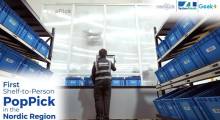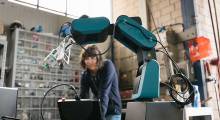Yesterday, Day 1 of ProMatDX, I focused on trends some of the industry’s leading system integrators were following. Today, I’ll look at robotics.
One of the presenters at last year’s NextGen Supply Chain Conference, the annual technology conference I produce, was Adrian Kumar, the global head of operations science & analytics at DHL Supply Chain. The topic was robotics: When it comes to putting robotics to work in the warehouse and distribution center, few organizations have worked with as many solution providers as Kumar’s team at DHL. Yet most of his presentation was about software.
When I asked him why, Kumar said simply that after more than three years of working with autonomous mobile robots (AMRs) in DHL’s operations, one of the most important learnings was that the software optimizing the robots and coordinating the rest of the fulfillment operations was more important to achieving results than the robots themselves. Essentially, the hardware is becoming a commodity.
That anecdote came as no surprise to Lior Elazary, the founder and CEO of inVia Robotics. He joked that at some point, someone will mass produce robots at such a cheap price that he’ll be able to concentrate on software. In fact, he described inVia “as a software company.” He is putting his money where his mouth is: inVia just announced a new project that utilizes the company’s warehouse execution system in a conventional distribution center with limited automation; robots will come later. He explained that the software can now “route a lift truck driver to get a pallet for the pallet area; route a cart runner who is delivering carts to the picking or packing areas; or direct a person in the pallet pick area.”
inVia isn’t the only company leading with software. Developing a solution to quickly and efficiently integrate the myriad automation platforms available today, including those from robotics suppliers, was the strategy behind SVT Robotics, co-founded by A.K. Schultz, SVT’s CEO. Despite it’s name, SVT doesn’t sell robots. Schultz and his partner Michael Howes are former Swisslog executives who were frustrated by the challenges of integrating software to create a holistic solution when they were working on projects for customers. They set out to build a better mousetrap – a Cloud-based platform where automation operating systems can be accessed and then integrated to create a solution. That includes robotics, as the name implies, but also more traditional automated equipment like conveyors, sorters and AS/RS systems. “Our goal was to take the typical 12 to 18 month integration cycle down to 12 to 18 weeks for deployment, especially for companies that are new to automation,” Schultz said. “We realize that it’s no longer about the machine, but the software.”
The ability for all those systems to play nice together is leading to another trend in robotics, one we’ll call convergence. Or, as I wrote yesterday, the transition from a point product to a holistic solution. Tom Galluzzo, the CEO of Pittsburgh-based IAM Robotics, noted that customers are looking at how to use AMRs, one of the products IAM produces, for conveyance over long distances in place of traditional conveyor, and as a sortation device to deliver totes to the different lanes for shipping. IAM is also one of the suppliers working with a systems integrator to create an highly-automated, end-to-end fulfillment engine that includes a piece picking robots, a robotic sorter and a high-density goods-to-person storage and retrieval system. “I think we’re on the verge of seeing more big and complex systems being designed,” Galluzzo said, “and we’re seeing a lot of new entrants to the market, addressing more applications.”
Without questions, AMRs are more widely adopted than piece-picking robots. To some degree that’s because AMRs are point solutions that require little in the way of infrastructure changes to get them up and running. Item-handling robots on the other hand have to work with other systems, requiring more software and hardware integration as well as infrastructure. But, that might be starting to change, noted Vince Martinelli, head of production and marketing at RightHand Robotics, one of the early movers in this space. One reason is that there are more reference systems up and running, and the deployments are getting larger. “Early on, companies were just installing one or two robots,” Martinelli said. “If you look at the project we just did with Apologistics in Germany, you’ll see that there are a lot of robots working.” You can’t underestimate the value of real case studies, he added. Look closely, and you’ll also see that the robots have been integrated with an AutoStore goods-to-robot storage and retrieval system – an example of convergence. In addition to experience and more reference case studies, the robot software, and integration of that software, is getting better. “APIs aren’t sexy,” Martinelli said. “But in our latest product, we emphasize more than ever how we can work with a system integrator.”
Robotics is a crowded field, one that is becoming more crowded every day as new startups throw their hats in the ring. At some point, I’m sure, there is going to be a shakeout. So, what may determine who survives? That’s a question that may be answered by data and experience. Robots, after all, rely on Artificial Intelligence to improve their performance, and AI needs data, the more the better. “The guy who gets 1,000 robots in there and operational first will learn a lot of things,” Martinelli said.







